| |
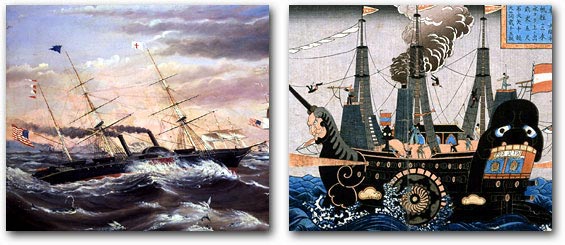 |
 “Carrying the ‘Gospel of God’ to the Heathen” “Carrying the ‘Gospel of God’ to the Heathen” |
American
warship, ca. 1854 |
 |
 Chicago
Historical Society Chicago
Historical Society |
© Nagasaki
Prefecture
|
On the 1853 voyage, Perry’s fleet consisted of two steam-driven frigates (the Mississippi and Susquehanna) and two sloops, with a total complement of 65 guns and a little less than 1,000 men. When he returned the following year,
his armada had grown to nine vessels, with the new flagship Powhatan joining the other two paddle-wheel warships. The crew had almost doubled to around 1,800, and mounted cannon now numbered over 100.
In Japanese parlance, the American vessels quickly became known as the “black ships”—probably from the color of their hulls, although it is sometimes said that the label derived from the clouds of smoke that hovered over the coal-burning ships.
Perry himself had played a major role in mechanizing the U.S. Navy, and the new steam technology persuaded all who saw it that the world had entered a new era. When his oldest steamer, the Mississippi, was launched in 1841, its huge engines were described as “iron earthquakes.” On the 1854 mission, the Mississippi consumed 2,336 pounds of coal per hour, while the corresponding figures for the less efficient Susquehanna and Powhatan were 3,310 pounds and 3,248 pounds respectively. To conserve fuel, all of the steamers hoisted sail as well.

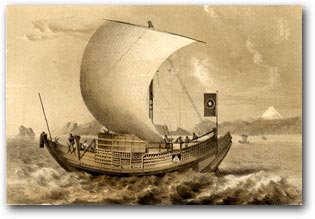
Japanese “junk” as recorded by the Perry
mission in the official Narrative |
Japan’s adoption of the “closed country” policy in the early-17th century involved not merely keeping foreigners out, but also keeping Japanese in. Thus, severe restrictions were placed on shipbuilding, and maritime activity was restricted to sailing small vessels in coastal waters. An illustration in the official narrative of the Perry mission depicted one of the single-sail “junks” that patrolled the waters outside Edo.

Even as pure sailboats, such modest vessels obviously could not compare with the great multi-mast ships of the foreign powers. Add steam engines and a battery of cannon, and it was all the more painfully apparent how far behind Japan had fallen during its long seclusion.
Ships captivate artists, and the visual record of Perry’s mission is no exception. Although Perry first arrived in Japan in 1853 with a fleet of only four vessels (and returned in 1854 with nine), in May 1852 Gleason’s Pictorial featured a stirring illustration of seven vessels it was originally anticipated would be “composing the Japanese Squadron.” In its Valentine’s Day edition of the following year, Gleason’s gave Commodore Perry a spectacular send-off with a two-page engraving of an even larger armada readying for departure. Titled, “A Superb View of the United States Japanese Squadron, Under the Command of Commodore Perry, Bound for the East,” this now well-known illustration included twelve vessels. Here, the artist merely expanded and rearranged the already imaginary earlier rendering. (Hand-tinted versions of both of these magazine illustrations often appear on the rare books and prints market.)
|
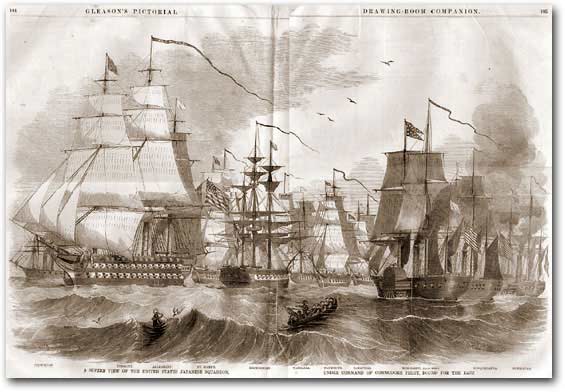 |
This dramatically imagined rendering of Perry’s squadron appeared in the February 12, 1853 issue of Gleason’s Pictorial. Perry is being rowed to his flagship on the first voyage, the steamer Mississippi. In fact, the 1853 mission was comprised of only four ships.
|
 |
 Photograph
of the Powhatan, Photograph
of the Powhatan,
which remained in service until 1887
US Naval Academy |
Model of the Powhatan,
flagship on the second voyage
Smithsonian Institution |

The Powhatan, Perry’s famous flagship on the second voyage,
survives in photographs, small-scale models, and—most spectacularly—the
romantic frontispiece of a now classic 1853 book by Charles Beebe Stuart titled Naval and Mail Steamers of the
United States. This luminescent,painterly rendering breathes romance and even mystery into this rather
stolid warship through the filtered light and near-mystic ambiance
associated with the “Turner school” of high-art
painting (named after the British artist Joseph Turner, who died in
1851).
|

 Oil
painting Oil
painting
of the Powhatan
from C. B. Stuart,
Naval and Mail
Steamers of
the United States,
1853
Yokohama Archives
of History
|
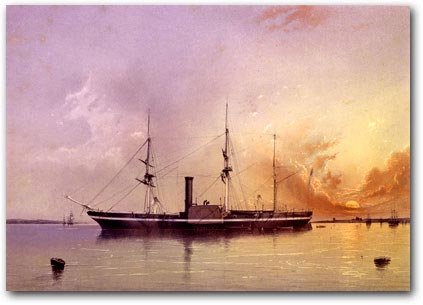 |
Perry’s
own artists captured the fleet both at rest and in turbulence, but
the most provocative rendering of the black ships at sea came from
a painter back home, who added a banner legend to his own imaginary
artwork to remind Americans that the commodore’s true mission
was literally divine. Perry himself usually spoke in terms of showing
the flag, opening the doors of
commerce, and spreading “civilization” to a backward people.
|
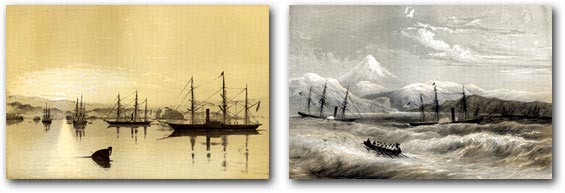 |

Perry’s fleet at anchor
and in turbulent seas,
as depicted in the
official Narrative
 |
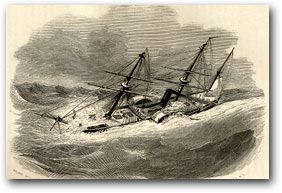 |
At the same time, it was widely understood that he was also returning
Christianity to a heathen society that had driven out such teachings
over two centuries previously. Accordingly, in this graphic rendering,
we behold both steamship and sailship plowing through frothy seas
above a large caption reading “U.S. JAPAN FLEET. Com. PERRY
carrying the ‘GOSPEL of GOD’ to the HEATHEN, 1853.”
|
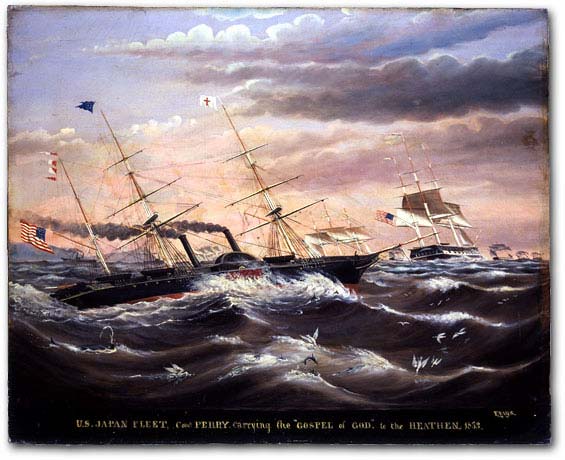 |
“U.S. JAPAN FLEET. Com.PERRY
carrying the ‘GOSPEL of GOD’ to the HEATHEN, 1853”
by James G. Evans, oil on canvas
Chicago Historical Society
|
One
person’s god may be another’s demon, of course. In this
regard, Japanese artists also gave free rein to their imaginations
by depicting the steam-driven black warships, almost literally, as
Darkness Incarnate. In the best-known print of this sort, the ship’s
hull is pitch black, smoke belches from its funnel, the figurehead
on the bow is a leering monster, portholes high in the stern glower
like the eyes of an apparition, the ship’s sides bristle with
rows of cannon, and gunfire streaks like a searchlight from a gun
near the bow as well as from another, unseen, at the stern.
|
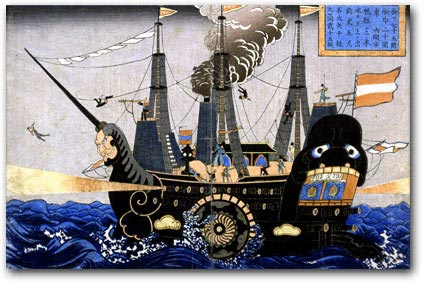 |
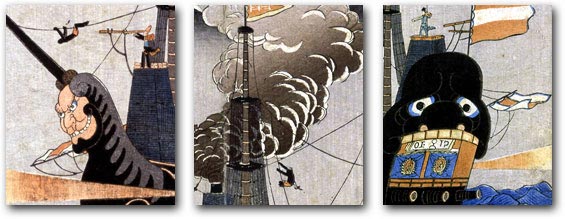 |

 American
warship, American
warship,
woodblock print
ca. 1854
Nagasaki Prefecture |
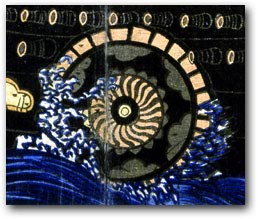 |
Although
woodblock prints as a genre were popular illustrations never intended
to be confused with fine art, the detail of this demonic rendering
reveals several aesthetic touches characteristic of traditional Japanese
design. We see this in the stylized curves of the waves and filigreed
rendering of whitecaps and splashing water, for example, as well as
in the distinctive pattern of the ship’s paddle-wheel.
In a demonic sister ship that was part of a larger painted montage,
many of the same features are present—and a touch more. Here
smoke from the coal-burning engines is streaked with forked tongues
of flame. To knowledgeable Japanese, these might well have evoked
classic artistic depictions of the fires of hell and the conflagrations
that consumed palaces and temples in an earlier era of civil wars.
|
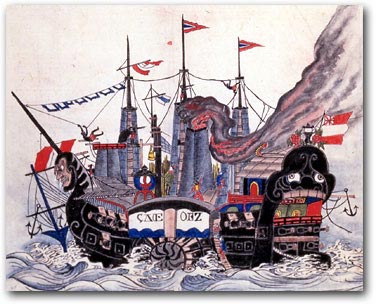 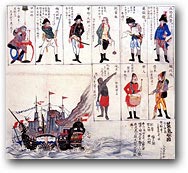 |
“Black Ship and Crew,”
watercolor on paper, ca. 1854
Ryosenji Treasure Museum
|
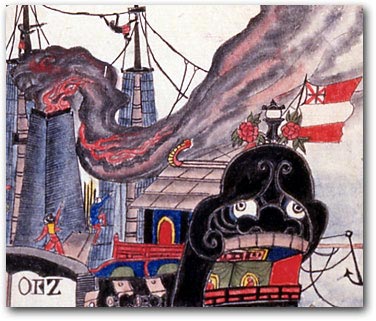 Like the blue eyeballs seen in occasional renderings of Perry and
other “barbarians,” however, even the demon ships are
more complicated and nuanced than they appear to be at first glance.
Take, for example, the rendering of the stern of the vessel: in each
of these graphics, this clearly has been turned into the eyes, nose,
mouth of a monster. Is it not obvious that this is meant to reflect
the monstrous nature of those who came with the ship? In fact, this
is not so obvious—for Asian seafarers of the time sometimes
placed huge demonic faces on the sterns of their vessels to ward off
evil spirits and ensure safe passage. Despite the seclusion policy,
a number of delegations from Korea visited Japan during the Tokugawa
period, for example, and we know from Japanese scrolls depicting these
missions that the Koreans themselves protected their fleet with fearsome
markings of this nature. Could this have influenced these particular
Japanese artists who sought to tell the populace about Perry’s
black ships? We cannot say.
Like the blue eyeballs seen in occasional renderings of Perry and
other “barbarians,” however, even the demon ships are
more complicated and nuanced than they appear to be at first glance.
Take, for example, the rendering of the stern of the vessel: in each
of these graphics, this clearly has been turned into the eyes, nose,
mouth of a monster. Is it not obvious that this is meant to reflect
the monstrous nature of those who came with the ship? In fact, this
is not so obvious—for Asian seafarers of the time sometimes
placed huge demonic faces on the sterns of their vessels to ward off
evil spirits and ensure safe passage. Despite the seclusion policy,
a number of delegations from Korea visited Japan during the Tokugawa
period, for example, and we know from Japanese scrolls depicting these
missions that the Koreans themselves protected their fleet with fearsome
markings of this nature. Could this have influenced these particular
Japanese artists who sought to tell the populace about Perry’s
black ships? We cannot say.
|
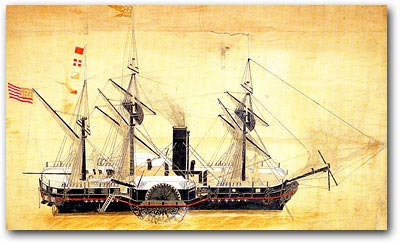 |
The Powhatan,
hanging scroll
1854 or later
Peabody Essex Museum
 |
Most
Japanese renderings of the black ships were more straightforward,
in any case, and provide a small but compelling example of how pictorial “realism”
may vary depending not only on the viewer, but also on the medium
of expression used. The handsome oil painting of the Powhatan in Charles
Beebe Stuart’s book, for example, was almost a mirror image
of the formal photograph of that vessel—and yet worlds apart
in its ambiance.
Japanese artists also portrayed the Powhatan and other black ships
“realistically,” from the same perfect-profile perspective—and
yet conveyed an entirely different impression.
|

 “Black
Ship at Shimoda,” “Black
Ship at Shimoda,”
painting
1854
Ryosenji Treasure Museum |
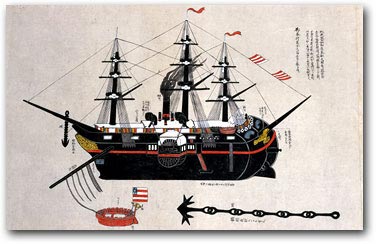 |
Perry’s
strategy of simultaneously impressing and intimidating the Japanese
included inviting some of their representatives to tour his flagship.
This made possible a small number of on-deck and below-deck depictions
of the details of the black ships. |
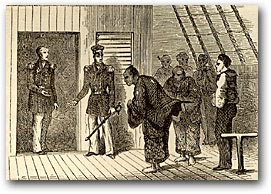
Japanese official on board
the Susquehanna from
the official Narrative.
|
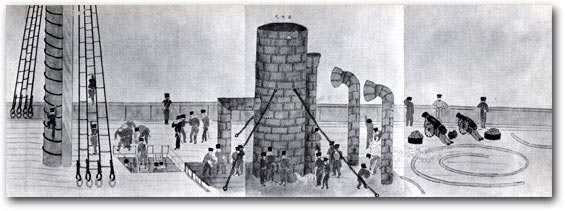 |
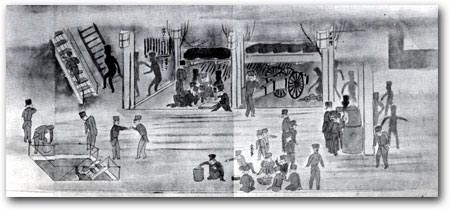 |

Japanese sketches
from on board
the Powhatan
1854
Library of Congress
|
Other artists, meanwhile, rendered the foreign intrusion from afar
with panoramic views of the American squadrons anchored in Japanese
waters. Such graphics, done in both color and black-and-white, often
were designed to convey detail concerning not only the black ships
but also the surrounding terrain.
|
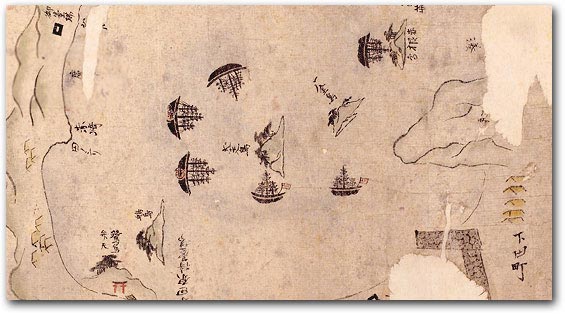 |
  Map of the harbor at Shimoda,
from the “Black Ship Scroll,” 1854 Map of the harbor at Shimoda,
from the “Black Ship Scroll,” 1854
Six of Perry’s gunboats rest at anchor. Place names (and ships)
appear rightsideup, upsidedown, and sideways—a convention that developed from maps being rotated
as they were read.
Honolulu Academy of Art
|
|
|

